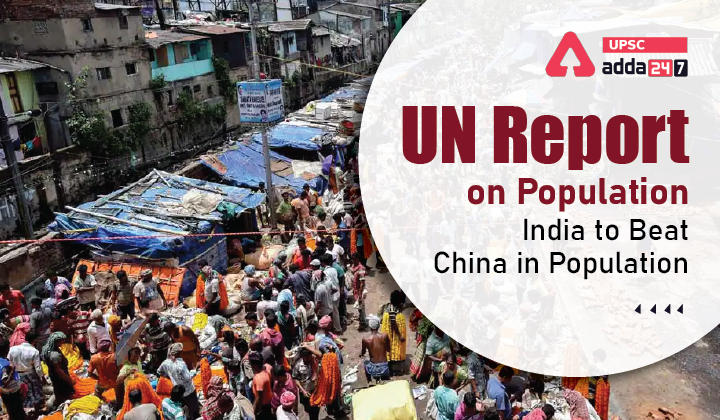Table of Contents
UN Population Report 2022- Relevance for UPSC Exam
UN Population Report: UN Population Report 2022 is an important document released by United Nations. UN Population Report 2022 is important for UPSC Mains Exam (GS Paper 2- International Relations- Important International institutions, agencies and fora- their structure, mandate.)
UN Population Report 2022 in News
- Recently, the Population Division of United Nations has released the UN Population Report 2022.
- According to the2022 edition of the United Nations’ World Population Prospects (WPP), released, India is projected to surpass China as the world’s most populous country in 2023.
- China’s population projected to decrease by 31.4 million, or around 2.2 per cent, between 2019 and 2050.
UN Population Report 2022 Findings
- Growing World Population: UN Population Report 2022 projected the world’s population to reach 8 billion on November 15, 2022.
- The global population is expected to grow to around 8.5 billion in 2030, 9.7 billion in 2050 and 10.4 billion in 2100.
- In 2020, the global growth rate fell under 1% per year for the first time since 1950.
- Continent-wise Population: Currently, with 4.7 billion Asia is the most populous continent and has 61 per cent of the global population.
- 17 per cent reside in Africa (1.3 billion),
- 10 per cent in Europe (750 million),
- 8 per cent in Latin America and the Caribbean (650 million), and
- The remaining 5 per cent in Northern America (370 million) and Oceania (43 million).
- Rates of Population Growth Across Regions and Countries:
- More than half of the projected increase in global population up to 2050 will be concentrated in just eight countries-
- The Democratic Republic of the Congo,
- Egypt,
- Ethiopia,
- India,
- Nigeria,
- Pakistan,
- the Philippines and
- the United Republic of Tanzania.
- The 46 least developed countries (LDCs) are among the world’s fastest-growing. Many are projected to double in population between 2022 and 2050-
- Putting additional pressure on resources and
- Posing challenges to the achievement of the UN’s Sustainable Development Goals (SDGs).
- Population Ageing: The population of older persons is increasing both in numbers and as a share of the total.
- The share of the global population aged 65 years or above is projected to rise from 10% in 2022 to 16% in 2050.
- Working Age Population: A sustained drop in fertility has led to an increased concentration of the population at working ages (between 25 and 64 years), creating an opportunity for accelerated economic growth per capita.
- This shift in the age distribution provides a time-bound opportunity for accelerated economic growth known as the “demographic dividend”.
- Role of International Migration: International migration is having important impacts on population trends for some countries.
- For high-income countries between 2000 and 2020, the contribution of international migration to population growth (net inflow of 80.5 million) exceeded the balance of births over deaths (66.2 million).
- Over the next few decades, migration will be the sole driver of population growth in high-income countries.
- Major Causes of International migration:
- In many of these countries, the outflows were due to temporary labour movements, such as for Pakistan (net flow of -16.5 million), India (-3.5 million), Bangladesh (-2.9 million), Nepal (-1.6 million) and Sri Lanka (-1.0 million).
- In other countries, including the Syrian Arab Republic (-4.6 million), Venezuela (Bolivarian Republic of) (-4.8 million) and Myanmar (-1.0 million), insecurity and conflict drove the outflow of migrants over this period.
- For high-income countries between 2000 and 2020, the contribution of international migration to population growth (net inflow of 80.5 million) exceeded the balance of births over deaths (66.2 million).
- More than half of the projected increase in global population up to 2050 will be concentrated in just eight countries-
United Nations’ World Population Prospects (WPP)
- About: The Population Division of the UN has been publishing the WPP in a biennial cycle since 1951.
- Mandate: Each revision of the UNWPP provides a historical time series of population indicators starting in 1950.
- It does so by taking into account newly released national data to revise estimates of past trends in fertility, mortality or international migration.
State of World Population 2022
https://www.adda247.com/upsc-exam/state-of-world-population-2022/





 TSPSC Group 1 Question Paper 2024, Downl...
TSPSC Group 1 Question Paper 2024, Downl...
 TSPSC Group 1 Answer key 2024 Out, Downl...
TSPSC Group 1 Answer key 2024 Out, Downl...
 UPSC Prelims 2024 Question Paper, Downlo...
UPSC Prelims 2024 Question Paper, Downlo...
